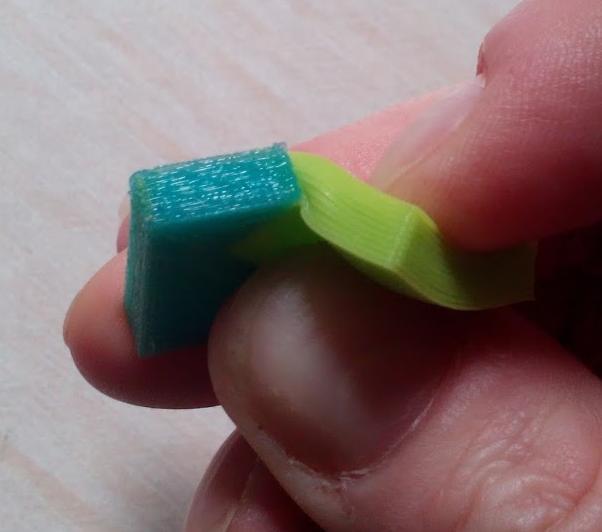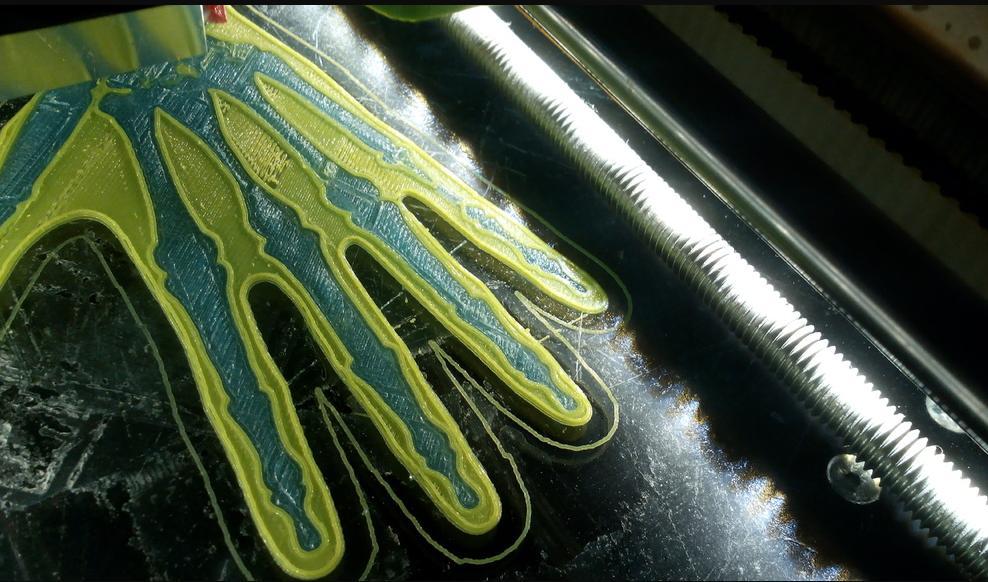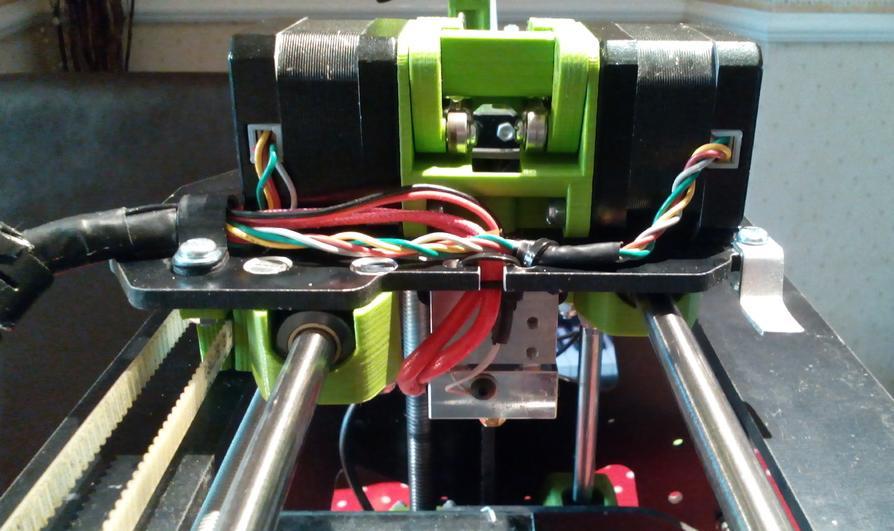Steve Wood Discovers How to 3D Print Flexible & Rigid Materials Within Single Layers of a Print – Takes Aim Toward Better Prostheses
 With the advent of various new materials which have suddenly become available within the desktop FFF/FDM 3D printing space, comes experimentation to the nth degree. It was only a few years ago that the thought of 3D printing materials with flexible properties was only a pipe dream. Today, not only do we have the option of printing with extremely flexible materials, but we can also print with composite materials which possess characteristics similar to wood, metal, and more.
With the advent of various new materials which have suddenly become available within the desktop FFF/FDM 3D printing space, comes experimentation to the nth degree. It was only a few years ago that the thought of 3D printing materials with flexible properties was only a pipe dream. Today, not only do we have the option of printing with extremely flexible materials, but we can also print with composite materials which possess characteristics similar to wood, metal, and more.
In the past, we have covered various stories concerning a brilliant man named Steve Wood. Wood, who is the founder of Gyrobot, has a very keen interest in working with flexible materials. At the same time, he also has been focusing quite a lot of his attention on creating new designs and methods of printing prosthetic hands for children in need. These two interests led him to develop a new micro extruder to go along with the E3D Cyclops Hotend on his 3D printer. With this extruder, he has found a method of 3D printing both flexible and rigid filaments within the same layers of a print. One of these tests came in the form of a little project he refers to as Flesh and Bones.
“‘Flesh and Bones’ is something I have been thinking about and pondering for a while due to my work on the Filaflex Remixes of the Flexy-Hands (3d printed prosthetic hand),” Wood tells 3DPrint.com. “I want to create a hand that is soft and tactile to touch and yet rigid enough to not collapse in an unorthodox manner. So my remit was to be able to print something that is both soft and hard in the same print in the same layer.”
This is exactly what “Flesh and Bones” was able to do. It proved Wood’s extruder capable of doing exactly what he set out to do. Using his 3-year-old RepRap style 3D printer, which is referred to as a Orca 0.43, Wood upgraded it with the new E3D Cyclops hotend which comes with dual filament inputs, yet only one nozzle for output. It has the ability to switch between these two filaments rather quickly. However, Wood still needed to overcome another issue if he were to attempt to 3D print with both flexible and rigid filaments within single layers.
“The second issue to overcome is that of extruder types for the Cyclops hot end, whilst a dual Bowden system is the most common for this use when using rigid filaments, it is pretty useless for Filaflex which is super soft,” Wood tells us. “There is just too much compression inside the Bowden feed tube. I therefore chose a dual direct drive approach incase I ever wanted to print with two different coloured flexible filaments at the same time. I modified an existing dual extruder design of mine to allow the Cyclops hot end to be fitted. This design, relative to other duals, is very small, lightweight and also easily printed.”
In addition to Wood’s modified hotend, he also needed to make changes to the slicing aspects for the objects he wished to print. He needed to create a program which would allow the Cyclops hot end to purge old material out of the chamber and then push through the new material for each color change.
“Whilst the Cylcops changes colour very quickly, it is not instant,” explains Wood. “Cura has a facility to print a small sacrificial cube to the side of your print, the area of which is editable. During a colour change, the printer prints a layer of this cube using the new colour, thus purging out the old colour before moving back on to the print again.”
 Wood tells us that the bonding between different material zones is very strong. This is helped by the fact that FilaFlex filament tends to stick very well to just about anything, but also a parameter setting that can be changed within Cura. This parameter allows users to control exactly how much overlap exists between the different material zones. While more of an overlap will decrease color sharpness, it will increase the strength of the bond.
Wood tells us that the bonding between different material zones is very strong. This is helped by the fact that FilaFlex filament tends to stick very well to just about anything, but also a parameter setting that can be changed within Cura. This parameter allows users to control exactly how much overlap exists between the different material zones. While more of an overlap will decrease color sharpness, it will increase the strength of the bond.
Next Wood would like to try out what he refers to as “pseudo material mixing using his hotend.
“I say pseudo because it is not a mixing hot end which can create a truly homogeneous material, but by using one flexible and one rigid filament input and extruding both at the same time then a stripy toothpaste effect will ensue,” Wood explains. “I would like to see using different ratios of input materials and the flow rate of each independently controlled how the properties are affected. Last year I created a piece of software called a Gcode Filament Mixer which would help me in this task. Multiple density and flexibility zones within the same print should be possible, both a designers dream and nightmare at the same time.”
 Ultimately Wood hopes that this will lead him to be able to create a better 3D printed prosthetic hand, one that is more realistic, having an internal rigid skeletal structure, and an outer structure printed in translucent and flexible Filaflex. It should definitely be interesting to follow Wood’s progress as he tries to reach this goal; a goal that doesn’t appear to be all that far off.
Ultimately Wood hopes that this will lead him to be able to create a better 3D printed prosthetic hand, one that is more realistic, having an internal rigid skeletal structure, and an outer structure printed in translucent and flexible Filaflex. It should definitely be interesting to follow Wood’s progress as he tries to reach this goal; a goal that doesn’t appear to be all that far off.
What do you think about the potential that Wood’s methods of printing will provide? Discuss in the Mixing Flexible and Rigid Filaments Within Layers forum thread on 3DPB.com.
Subscribe to Our Email Newsletter
Stay up-to-date on all the latest news from the 3D printing industry and receive information and offers from third party vendors.
You May Also Like
3D Printing News Briefs, April 13, 2024: Robotics, Orthotics, & Hypersonics
In 3D Printing News Briefs today, we’re focusing first on robotics, as Carnegie Mellon University’s new Robotics Innovation Center will house several community outreach programs, and Ugogo3D is now working...
3D Printing Webinar and Event Roundup: March 24, 2024
We’ve got a very busy week of webinars and events, starting with Global Industrie Paris and a members-only roundtable for AM Coalition. Stratasys will continue its advanced in-person training and...
MIMO TECHNIK, ASTRO Test Lab & LEAP 71 Combine Powers for Computational Engineering in Aerospace 3D Printing
California-based MIMO TECHNIK, a service bureau catering to demanding clients in the New Space and defense sectors, operates with six SLM 500s, four SLM 280s, and three SLM 125s. ASTRO...
EOS Taps 1000 Kelvin for “First” AI Co-pilot for 3D Printing
Additive manufacturing (AM) startup 1000 Kelvin has joined forces with EOS to integrate AMAIZE, a pioneering artificial intelligence (AI) co-pilot for AM, into the EOS software suite. The solution aims...































